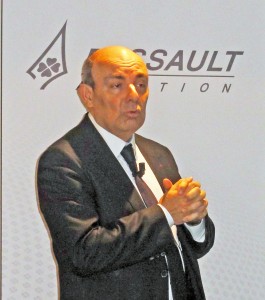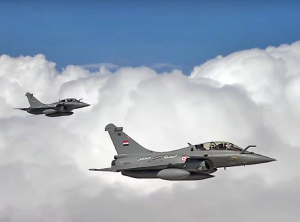Dassault Aviation ends 2015 in high water
By Jean-Michel Guhl
During the traditional spring press meeting held on Dassault Aviation’s cosy barge « la péniche » in Saint-Cloud, on last 10 March 2016, Éric Trappier, Chairman and Chief Executive Officer of the French company, revisited for the newsmen and women the year 2015. Just like the river Seine waters at this time had reached a high level, the situation is quite similar for Dassault today. The Board of Directors, chaired a day before by Mr. Trappier, closed the 2015 financial statements.
Mr. Trappier opened the press conference stating: The year 2015 will first and foremost be the year of the attacks that dramatically struck France in January and November. In this struggle against terrorism, as always when France is militarily engaged, we stand aside our forces and give them all the support they need in their military operations. Economically, the year has neither been stable. It was marked by a sharp slowdown in economies of emerging countries such as China, Brazil and Russia, the drop in oil prices and the recovery of the dollar against the euro.

In this environment, 2015 was a contrasted year for Dassault Aviation.
Regarding military aircraft, the year was marked by:
· the signing of the first two export contracts for the Rafale, with 24 aircraft ordered by Egypt and 24 by Qatar, bringing the number of aircraft ordered to 48 in 2015.
· the announcement by the Indian Prime Minister Mahendra Modi of his country’s intention to buy 36 fly away Rafales.
· the delivery of 8 Rafales in 2015: 5 to France and 3 to Egypt,
· the delivery of 3 Rafale Marine retrofitted to the F3 standard to the French Navy,
· the delivery of 2 Indian Mirage 2000H/TH upgraded to the Mirage 2000I/TI standard in France, and continued support for HAL (Hindustan Aeronautics Ltd) for the following aircraft in India,
· the delivery to France of the 2 last Falcon 50 SURMAR, out of 4 aircraft ordered,
· the 100th flight of the nEUROn in Istres and its first strike using live bombs during the Saab campaign in Sweden,
· the announcement by the French, German and Italian governments of their intention to select Dassault Aviation, Airbus DS and Finmeccanica to conduct a 2-year definition study for a MALE (Medium Altitude Long Endurance) drone with existing European technologies. The Organization for Joint Armament Cooperation (OCCAR) is responsible for notifying the contract.
Regarding business jet aircraft, 2015 was marked by:
· disappointing order intake in a difficult competitive environment largeley linked to the downfall in the BRIC nations. Hence Falcon sales slowed in 2015: 45 aircraft were ordered (compared to 90 in 2014) and 20 Falcons previously on order from NetJets were canceled,
· the delivery of 55 Falcons, whereas we had planned 65. The negative gap is linked to the low number of aircraft orders recorded in 2015,
· the first flight of the Falcon 8X in early February. The 2015 test programme proceeded in line with the company’s expectations. The test aircraft completed 250 missions representing 450 flight hours. Certification is planned for mid-2016. Interior completion work was begun on five aircraft at the end of 2015. The first aircraft should be delivered to customers in the second half of 2016,
· regarding the Falcon 5X, SNECMA’s difficulties in the development of the SilverCrest engine and their new related schedule (postponement of the engine certification from 2015 to 2018) came as a sudden blow for Dassault Aviation. This serious mishap has forced the company to:
‐ temporarily freeze production internally and externally,
‐ readjust in 2016 the Falcon 5X program schedule, with the first deliveries planned during the first-half of 2020. Customers were informed of this change and this obviously came as a bitter disappointment to many.
· the order by the Japan Coast Guards of 2 Falcon 2000 Maritime Surveillance aircraft,
· the launch of the new and very innovative Falcon Response solution, which provides unique on-the-spot after-sales service to customers,
· the inauguration of the new hangar in Little Rock Nebraska’s plant to accommodate new Falcon programmes for interior completion,
· the laying of the first stone for the future service station of Dassault Falcon Service subsidiary in Bodeaux-Mérignac.
The year 2015 also marked a turning point in DA’s capital history with the sale by Airbus Group SAS of their 18.75% of DA’s capital. This sale will enable new investors to enter the company’s capital. It also reinforces the historical and main shareholder, GIMD, warrant of further stability for Dassault Aviation.
After a 2015 year full of contrasts, which more than ever showed the importance of the company’s dual business, civil and military, Dassault is set to face many more challenges in 2016:
These are, in the military domain,
· to continue negotiations with Rafale export prospects; the signing of new contracts is necessary to guarantee the fighter’s ramping-up. Accordingly, DA is still working on the signing of the contract for 36 Rafales with India,
· to continue to support and train the Egyptian Air Force, after the delivery of the 6 first Rafales in 2015 and 2016,
· to start production of the Rafale for Qatar,
· to extend the nEUROn program while waiting for the launching of a true all-European UCAV programme, which is essential to the sustainability of DA’s combat aircraft sector,
· to sign a study contract concerning a European MALE drone programme aimed at replacing the Harfang and Reaper drones of the French Air Force into the next decade.
These are also in the civil aircraft domain:
· to boost Falcon sales,
· to make the entry into service of the new long-ra,ge Falcon 8X a success,
· to ensure the progress of SNECMA’s troublesome Silvercrest engine and to secure the new schedule for the first Falcon 5X aircraft deliveries during the first-half of 2020,
· to continue DA’s efforts to improve after-sales service to Falcon customers,
· to prepare the technological building blocks of future Falcon aircraft bizjets,
Dassault Aviation is set on improving competitiveness, in a highly competitive environment, by lowering cost price that directly impact sales prices despite the decline in the euro currency. A deep transformation of the company is envisioned in order to reach a level of industrial efficiency and economic performance that can beat the competition while generating the margins needed for future investments. DA is also set on increasing flexibility in order to improve responsiveness to sudden changes in the market, which is more and more unpredictable in an increasingly uncertain world.
Finally, Éric Trappier was pleased to announce the coming celebration of the 100th anniversary of the Dassault aircraft company in 2016. This celebration will the company the opportunity to pay tribute to the founder, Marcel Bloch Dassault who first started his liaison with French military aviation in 1916 with the Éclair propeller fitted to the famous SPAD VII biplane.
Order intake
2015 consolidated order intake was EUR 9,884 million, compared to EUR 4,639 million in 2014. Export represented 96%.
The order intake consists exclusively of firm orders.
45 Falcons were ordered (compared to 90 ordered in 2014), and 20 previous NetJets orders were canceled. Accordingly, consolidated Falcon order intake represented EUR 1,602 million, compared to EUR3,946 million in 2014. The decline in order intake was due to a difficult economic environment. After a growth in Falcon activity in 2014, the economic situation, especially in emerging countries, weighed heavily on
our prospects and customers and therefore on the level of 2015 order intake, Mr. Trappier said.
Defence order intake came to EUR 8,282 million in 2015, compared to EUR 693 million in 2014. This large increase is due to the coming into force in 2015 of the contracts for Egypt (24 Rafales) and Qatar (24 Rafales). Dassault Aviation recognizes the Rafale export contracts in their entirety (i.e. including the Thales and SNECMA parts), whereas for France, only the Dassault Aviation part is recognized.
Net sales
2015 consolidated net sales amounted to EUR 4,176 million compared to EUR 3,680 million in 2014. Export represented 83%. 2015 Falcon net sales amounted to EUR 2,507 million compared to EUR 2,685 million in 2014. 55 new aircraft were delivered in 2015, compared to 66 in 2014. This decrease in deliveries is due to the low number of 2015 orders. This explains why we did not achieve our forecast of 65 deliveries in 2015. 2015 defence net sales amounted to EUR 1,669 million compared to EUR 995 million in 2014. Five Rafales
were delivered to France and three to Egypt during 2015. Defence net sales also included the delivery of works performed for the Indian Mirage 2000H/TH aircraft upgraded to the I/TI standard and the Rafale Ms retrofitted to the F3 standard.
Backlog
The consolidated backlog at December 31, 2015, was EUR 14,175 million compared to EUR 8,217 million at 2014 year’s end. The increase was due to 2015 Rafale export orders.
Defence rxport represented 55% of backlog, Falcon 27%, and Defence France 18%.
It included in particular:
· 21 Rafales for Egypt and 24 for Qatar,
· 38 Rafales for France (43 at 2014 year’s end),
· 91 Falcons (121 at 2014 year’s end).
Operating income
2015 operating income was EUR 361 million compared to EUR 353 million in 2014.
The operating margin was 8.6% compared to 9.6% in 2014. The decrease is due in particular to:
· the pressure on FALCON sales prices due to an extremely competitive environment,
· the average US$ rate effect ($ 1.11/EUR in 2015 compared to $ 1.33/EUR in 2014) on Falcon net sales part covered naturally by the USD purchases,
· the favorable impact in 2014 of exceptional items such as the sale of a building in Istres.
2016 outlook
The Group expects to deliver around sixty Falcons and nine Rafales in 2016 (including retrofitted aircraft for the French Navy). Thus net sales in 2016 should, however, be lower than in 2015 given other activities (2015 was favorably impacted in particular by the upgrade of Indian Mirage 2000s).

